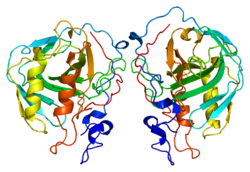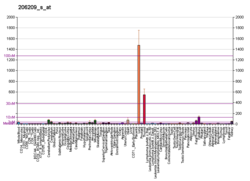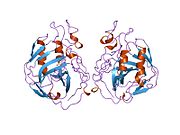Carbonic anhydrase 4
Carbonic anhydrase 4is anenzymethat in humans is encoded by theCA4gene.[5][6]
Function
[edit]Carbonic anhydrases (CAs) are a large family of zinc metalloenzymes that catalyze the reversible hydration of carbon dioxide. They participate in a variety of biological processes, including respiration, calcification, acid-base balance, bone resorption, and the formation of aqueous humor, cerebrospinal fluid, saliva, and gastric acid. They show extensive diversity in tissue distribution and in their subcellular localization. CA IV is a glycosylphosphatidyl-inositol-anchored membrane isozyme expressed on the luminal surfaces of pulmonary (and certain other) capillaries and of proximal renal tubules. Its exact function is not known, however, it may have a role in inherited renal abnormalities of bicarbonate transport.[6]
CA IV has been identified in pulmonary epithelium of many mammalian species and may be uniquely adaptive for gas exchange necessary for the high metabolic requirements of mammals. A majority of the CO2produced by metabolism is transported as bicarbonate (HCO−
3). At the tissue capillary, CO2diffuses from tissue to plasma. Other forms of carbonic anhydrase enzyme are not present in the plasma, restricting the equilibrium reaction of CO2+H2O=H
2CO
3= H+HCO−
3.CO2in the plasma diffuses into the Red Blood Cell. CA is present within the Red Blood Cell, facilitating the conversion of CO2toHCO−
3.HCO−
3so produced is transferred by theHCO−
3/Cl- "shuttle" from the interior of the Red Blood Cell to the plasma.HCO−
3does not diffuse across cell membranes and, in the absence of CA, stays asHCO−
3and concentrates in plasma. Up to 80% of metabolically produced CO2is transported in plasma in the form ofHCO−
3.Blood moves from the tissue capillary to the pulmonary capillary where CO2is exchanged at the lung. In the pulmonary capillary, bicarbonate can not simply diffuse either into the Red Blood Cell or the alveoli. It is traditionally thought thatHCO−
3is returned to the interior of the Red Blood Cell by a reversal of theHCO−
3/Cl- shuttle, where, in the presence of CA, it is returned to a CO2form to diffuse from the interior of the Red Blood Cell, to the plasma and then into the alveoli. Membrane bound CA (CA IV) on the luminal side of the pulmonary membrane would have direct contact with plasmaHCO−
3and would enzymatically convertHCO−
3to CO2in the area immediately proximal to the exchange membrane, greatly increasing the concentration gradient for exchange. In this way, plasmaHCO−
3can be converted to CO2within the plasma compartment and exchanged with the alveoli without the requirement of returning theHCO−
3to the interior of the Red Blood Cell.
Interactions
[edit]CA4 has been shown tointeractwithBand 3.[7]
References
[edit]- ^abcGRCh38: Ensembl release 89: ENSG00000167434–Ensembl,May 2017
- ^abcGRCm38: Ensembl release 89: ENSMUSG00000000805–Ensembl,May 2017
- ^"Human PubMed Reference:".National Center for Biotechnology Information, U.S. National Library of Medicine.
- ^"Mouse PubMed Reference:".National Center for Biotechnology Information, U.S. National Library of Medicine.
- ^Okuyama T, Batanian JR, Sly WS (Aug 1993). "Genomic organization and localization of gene for human carbonic anhydrase IV to chromosome 17q".Genomics.16(3): 678–84.doi:10.1006/geno.1993.1247.PMID8325641.
- ^ab"Entrez Gene: CA4 carbonic anhydrase IV".
- ^Sterling D, Alvarez BV, Casey JR (Jul 2002)."The extracellular component of a transport metabolon. Extracellular loop 4 of the human AE1 Cl-/HCO3- exchanger binds carbonic anhydrase IV".J. Biol. Chem.277(28): 25239–46.doi:10.1074/jbc.M202562200.PMID11994299.
Send to
Further reading
[edit]- Okuyama T, Sato S, Zhu XL, Waheed A, Sly WS (1992)."Human carbonic anhydrase IV: cDNA cloning, sequence comparison, and expression in COS cell membranes".Proc. Natl. Acad. Sci. U.S.A.89(4): 1315–9.Bibcode:1992PNAS...89.1315O.doi:10.1073/pnas.89.4.1315.PMC48440.PMID1311094.
- Hageman GS, Zhu XL, Waheed A, Sly WS (1991)."Localization of carbonic anhydrase IV in a specific capillary bed of the human eye".Proc. Natl. Acad. Sci. U.S.A.88(7): 2716–20.Bibcode:1991PNAS...88.2716H.doi:10.1073/pnas.88.7.2716.PMC51309.PMID1901414.
- Zhu XL, Sly WS (1990)."Carbonic anhydrase IV from human lung. Purification, characterization, and comparison with membrane carbonic anhydrase from human kidney".J. Biol. Chem.265(15): 8795–801.doi:10.1016/S0021-9258(19)38958-6.PMID2111324.
- Carter ND, Fryer A, Grant AG, Hume R, Strange RG, Wistrand PJ (1990). "Membrane specific carbonic anhydrase (CAIV) expression in human tissues".Biochim. Biophys. Acta.1026(1): 113–6.doi:10.1016/0005-2736(90)90340-T.PMID2116168.
- Whitney PL, Briggle TV (1982)."Membrane-associated carbonic anhydrase purified from bovine lung".J. Biol. Chem.257(20): 12056–9.doi:10.1016/S0021-9258(18)33676-7.PMID6811592.
- Bardien S, Ebenezer N, Greenberg J, Inglehearn CF, Bartmann L, Goliath R, Beighton P, Ramesar R, Bhattacharya SS (1995). "An eighth locus for autosomal dominant retinitis pigmentosa is linked to chromosome 17q".Hum. Mol. Genet.4(8): 1459–62.doi:10.1093/hmg/4.8.1459.PMID7581389.
- Okuyama T, Waheed A, Kusumoto W, Zhu XL, Sly WS (1995). "Carbonic anhydrase IV: role of removal of C-terminal domain in glycosylphosphatidylinositol anchoring and realization of enzyme activity".Arch. Biochem. Biophys.320(2): 315–22.doi:10.1016/0003-9861(95)90015-2.PMID7625839.
- Mahieu I, Benjamin A, Stephens R, Walters D, Carter N (1995). "Characterization of membrane bound carbonic anhydrase IV (CA IV) located on the external surface of lung pulmonary endothelial cells".Biochem. Soc. Trans.23(2): 320S.doi:10.1042/bst023320s.PMID7672351.
- Sender S, Gros G, Waheed A, Hageman GS, Sly WS (1994)."Immunohistochemical localization of carbonic anhydrase IV in capillaries of rat and human skeletal muscle".J. Histochem. Cytochem.42(9): 1229–36.doi:10.1177/42.9.8064130.PMID8064130.
- Fleming RE, Parkkila S, Parkkila AK, Rajaniemi H, Waheed A, Sly WS (1996)."Carbonic anhydrase IV expression in rat and human gastrointestinal tract regional, cellular, and subcellular localization".J. Clin. Invest.96(6): 2907–13.doi:10.1172/JCI118362.PMC186002.PMID8675662.
- Waheed A, Okuyama T, Heyduk T, Sly WS (1996). "Carbonic anhydrase IV: purification of a secretory form of the recombinant human enzyme and identification of the positions and importance of its disulfide bonds".Arch. Biochem. Biophys.333(2): 432–8.doi:10.1006/abbi.1996.0412.PMID8809084.
- Parkkila S, Parkkila AK, Juvonen T, Waheed A, Sly WS, Saarnio J, Kaunisto K, Kellokumpu S, Rajaniemi H (1996). "Membrane-bound carbonic anhydrase IV is expressed in the luminal plasma membrane of the human gallbladder epithelium".Hepatology.24(5): 1104–8.doi:10.1002/hep.510240521.PMID8903383.S2CID11461543.
- Stams T, Nair SK, Okuyama T, Waheed A, Sly WS,Christianson DW(1997)."Crystal structure of the secretory form of membrane-associated human carbonic anhydrase IV at 2.8-A resolution".Proc. Natl. Acad. Sci. U.S.A.93(24): 13589–94.doi:10.1073/pnas.93.24.13589.PMC19359.PMID8942978.
- Bardien S, Ramesar R, Bhattacharya S, Greenberg J (1997). "Retinitis pigmentosa locus on 17q (RP17): fine localization to 17q22 and exclusion of the PDEG and TIMP2 genes".Hum. Genet.101(1): 13–7.doi:10.1007/s004390050577.PMID9385361.S2CID26680917.
- Sender S, Decker B, Fenske CD, Sly WS, Carter ND, Gros G (1998)."Localization of carbonic anhydrase IV in rat and human heart muscle".J. Histochem. Cytochem.46(7): 855–61.doi:10.1177/002215549804600709.PMID9632745.
- Wistrand PJ, Carter ND, Conroy CW, Mahieu I (1999). "Carbonic anhydrase IV activity is localized on the exterior surface of human erythrocytes".Acta Physiol. Scand.165(2): 211–8.doi:10.1046/j.1365-201x.1999.00478.x.PMID10090333.
- Fujikawa-Adachi K, Nishimori I, Sakamoto S, Morita M, Onishi S, Yonezawa S, Hollingsworth MA (1999). "Identification of carbonic anhydrase IV and VI mRNA expression in human pancreas and salivary glands".Pancreas.18(4): 329–35.doi:10.1097/00006676-199905000-00001.PMID10231836.
- Sterling D, Alvarez BV, Casey JR (2002)."The extracellular component of a transport metabolon. Extracellular loop 4 of the human AE1 Cl-/HCO3- exchanger binds carbonic anhydrase IV".J. Biol. Chem.277(28): 25239–46.doi:10.1074/jbc.M202562200.PMID11994299.
External links
[edit]- GeneReviews/NCBI/NIH/UW entry on Retinitis Pigmentosa Overview
- Overview of all the structural information available in thePDBforUniProt:P22748(Carbonic anhydrase 4) at thePDBe-KB.








